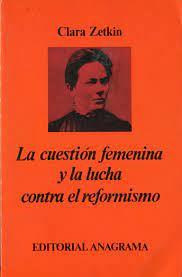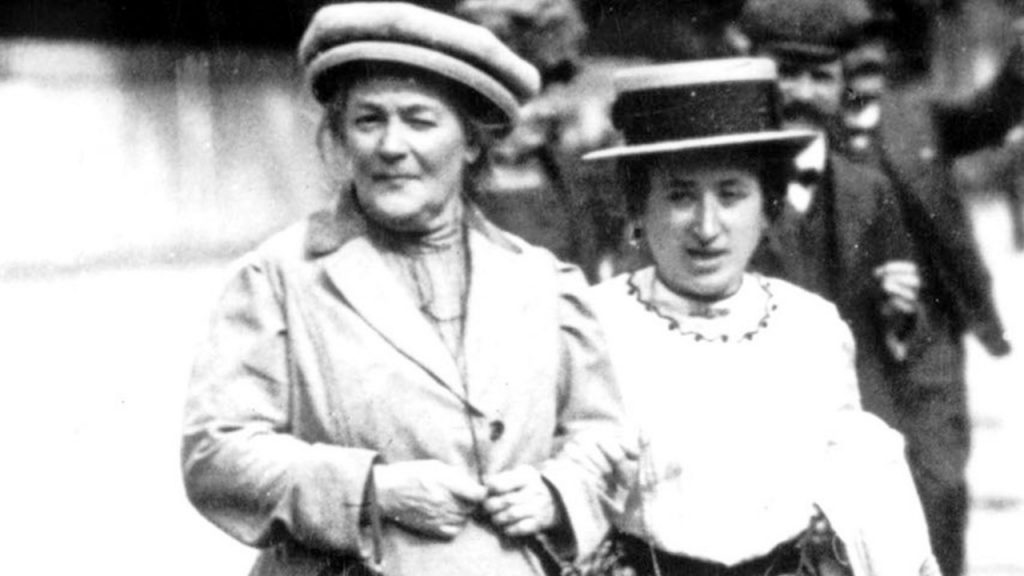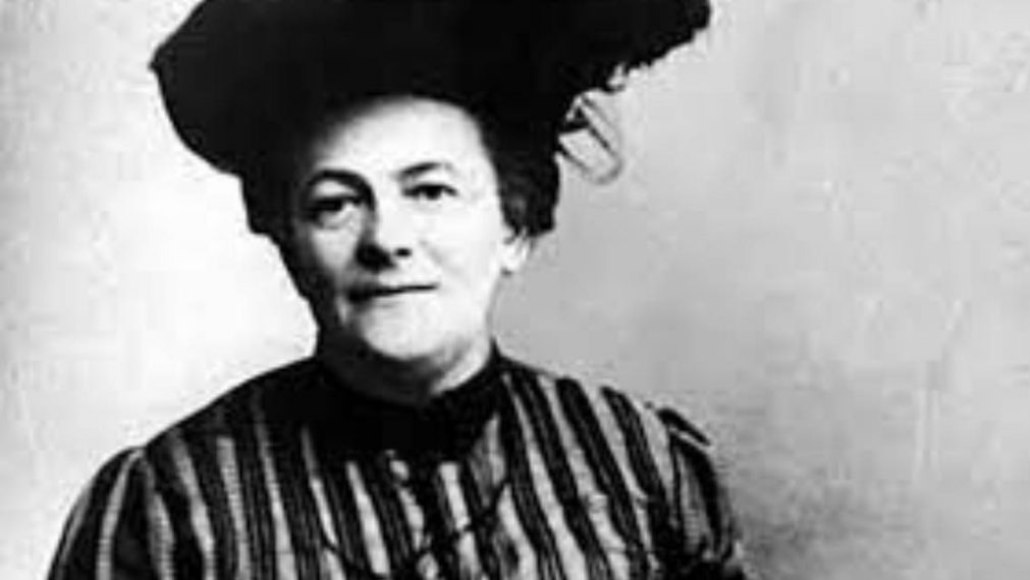Por Caro Dome
Pionera de la organización de las mujeres trabajadoras y socialistas. Periodista, maestra, política, militante, ferviente organizadora de la revolución. Fue fundadora de la Segunda Internacional y opositora a la dirección socialdemócrata cuando esta apoyó la Primera Guerra Mundial. Impulsó la Liga Espartaco y la formación del Partido Comunista alemán jugando un papel fundamental en la historia del socialismo y del movimiento de mujeres.
No alcanza una bio…
Clara Zetkin vivió entre dos siglos. Nació el 5 de Julio de 1857 en la ciudad alemana de Wiedenau (Sajonia) y murió el 20 de junio de 1933 en Moscú. Comenzó a militar a sus 20 años en el Partido Socialista Obrero de Alemania, (posteriormente, Partido Socialdemócrata Alemán, SPD), en una época en que las mujeres tenían prohibido participar en política. En 1882 se exilió en Zúrich huyendo de las leyes antisocialistas de Bismarck y después en París, donde vivió con sus hijos y con su esposo, Ossip Zetkin. Se alojaron en un pequeño cuarto en Montmartre, barrio de artistas e intelectuales, donde Clara obtuvo una amplia formación. Desde allí tomó contacto con dirigentxs marxistas del movimiento obrero francés, entre ellos Jenny y Laura Marx (hijas de Karl), Paul Lafargue y Jules Guesde, y luego jugó un importante rol en la fundación de la Segunda Internacional. En 1889, durante la sesión del 19 de julio del Congreso Fundacional de la Segunda Internacional celebrado en París, Clara escribió:
“No creemos que para nuestra plena emancipación baste ni nuestra admisión en el sistema de la llamada libre empresa, ni un acceso igualitario a la educación (aunque ambas exigencias sean naturales y justas), como tampoco la conquista de derechos políticos. Los países que han concedido un sufragio universal, libre y directo muestran lo poco que esto vale. Si no viene acompañado de la libertad económica, el derecho al voto sería un cambio sin rumbo. Si la emancipación social dependiera de los derechos políticos, en los países con derecho al voto universal no existiría la cuestión social. La emancipación de las mujeres, como la emancipación de todo el género humano, sólo ocurrirá dentro del marco de la emancipación del trabajo con respecto al capital.”
Tales posiciones enfrentaron, por un lado, al sufragismo (que al estar integrado mayormente por mujeres de clases sociales acomodadas, no tenía un horizonte más amplio que la conquista de los derechos civiles y políticos de las mujeres) y, por otro lado, a las resistencias del propio movimiento socialdemócrata a la hora de incluir “la cuestión de la mujer” en su programa. En ese sentido, la firmeza de los criterios y posicionamientos de Clara, fueron los que la convirtieron en la gran organizadora de las mujeres revolucionarias de su tiempo.

Organizadora, socialista, internacionalista
Después del fallecimiento de Ossip Zetkin, Clara regresa a Alemania en 1890, cuando el SPD era una organización de masas. Desde 1892 Clara dirigió la revista La Igualdad (Die Gleichheit) e integró activamente el ala izquierda del partido. Junto con Rosa Luxemburgo enfrentaron las teorías revisionistas de Eduard Bernstein, defendiendo las tesis marxistas en el dilema Reforma o Revolución.
En 1902 la prohibición a la política femenina fue reformada en Alemania: a partir de entonces, las mujeres tuvieron derecho a la actividad política, pero siempre y cuando la ejercieran separadas de los hombres; razón por la que Zetkin comenzó a organizar la sección femenina del SPD. A la cabeza de la misma, organizó las Conferencias Internacionales de Mujeres Socialistas y luchó por el derecho al voto, delimitando la idea de que con las mujeres burguesas había que “luchar juntas, marchar separadas”. Su línea fue triunfante, logrando que la socialdemocracia alemana fuera el primer partido político europeo en incluir este derecho en su programa.
En agosto de 1907, Zetkin lideró la Primera Conferencia Internacional de Mujeres Socialistas. Participaron 58 delegadas de 15 países.
Según Zetkin, la conferencia fue “el primer paso para establecer un contacto regular entre las mujeres socialistas de los diferentes países… para incrementar la fuerza y asegurar el éxito de la actividad y la lucha del movimiento de mujeres”. Las diferencias que se expresaron en la misma encontraron a Clara Zetkin y a Alejandra Kollontai del lado de la defensa irrestricta del sufragio femenino. En cambio, la reformista Lily Braun estaba dispuesta a aceptar “compromisos”. Finalmente, la reunión estableció un Secretariado Internacional, encabezado por Zetkin.
La Segunda Conferencia Internacional de Mujeres Socialistas tuvo lugar en Copenhague en agosto de 1910. Allí fue cuando Zetkin propuso establecer un Día Internacional de las Mujeres Trabajadoras, lo que fue aprobado por más de 100 delegadas de 17 países. La conferencia también debatió sobre los derechos laborales, la educación y la lucha contra la guerra, cada vez más cercana. En 1911 se celebró por primera vez en Berlín el Día Internacional de las Mujeres Trabajadoras, con más de 30.000 manifestantes.
La Tercera Conferencia estaba fechada para abril de 1914, pero no se pudo realizar. La guerra aceleró los acontecimientos y la clase obrera europea se encontró dividida. La lucha contra la masacre imperialista encontró a Zetkin a la vanguardia junto a Rosa Luxemburgo. Ambas rechazaron la adaptación de la socialdemocracia a la cruzada patriota y su traición al internacionalismo revolucionario. Junto a Karl Liebknecht y Rosa Luxemburgo formaron la Liga Espartaco y editaron la revista La Internacional. En marzo de 1915, Zetkin organizó una Conferencia Internacional de Mujeres contra la Guerra, que contó con 25 delegadas de países beligerantes, dejando en claro que su propuesta seguía a la orden del día.

Del lado de la Revolución
Por su defensa de los principios internacionalistas, tanto Clara Zetkin como Rosa Luxemburgo sufrieron la cárcel y el exilio durante la guerra. Esto las llevó a unirse a Lenin, Trotsky y otros dirigentes socialdemócratas de distintos países, con los que compartían su oposición al rumbo tomado por la mayoría de la socialdemocracia. La guerra y el inminente estallido de las revoluciones habían dividido a la socialdemocracia entre reformistas y revolucionarios. Por eso, cuando en 1917 estalló la revolución rusa, tanto Clara como Rosa recibieron con fervor las noticias y participaron activamente de la Revolución alemana de 1918, la cual finalmente fue derrotada. El 29 de enero de 1919, tan solo 14 días después del asesinato de Rosa Luxemburgo, Zetkin fue la primera mujer en hablar en el Parlamento alemán, y denunció al gobierno socialdemócrata por aniquilar la revolución.
Ese mismo año, la fundación de la Tercera Internacional, dirigida por Lenin, fue el proyecto que se propuso romper definitivamente con los elementos reformistas que habían traicionado a la clase trabajadora. Allí Zetnik profundizó su vínculo con Lenin y lideró la Internacional de las Mujeres Comunistas, hasta su disolución en 1925. Sus diálogos (y polémicas) con Lenin sobre la cuestión femenina están retratados afectuosamente en sus Recuerdos de Lenin.
Durante los años siguientes formó parte del Partido Comunista, aunque confrontó a su Comité Central por diferencias políticas. Luego, entre 1922 y 1933 ejerció como diputada en el Reichstag -aunque seguía residiendo en Moscú-. Su mal estado de salud la aisló por momentos de la vida política, y si bien nunca se opuso públicamente al estalinismo, existen cartas privadas en las que manifestó su gran malestar con el régimen estalinista y sus persecuciones al pensamiento crítico. No obstante, se puede ver a la figura de Stalin levantando su féretro el día de su muerte, en Moscú en 1933.

Tesis para la propaganda entre mujeres trabajadoras
Lenin le encargó a Zetkin la elaboración de unas tesis para el trabajo político entre las mujeres. Las mismas, serían refrendadas en el III° Congreso de la Internacional Comunista. Allí, Clara señalaba que había que “admitir a las mujeres como miembros con idénticos deberes y derechos que el resto de los miembros en el partido y en todas las organizaciones proletarias (sindicatos, cooperativas, consejos de fábrica, etc.)”, como también “combatir los prejuicios relativos a las mujeres en las masas del proletariado masculino, fortaleciendo en el espíritu de los obreros y las obreras la idea de la solidaridad de intereses de los proletarios de ambos sexos.” Su convicción, se basaba en la idea de que el trabajo político entre las mujeres debía ser la “agitación y propaganda por medio de los hechos” para “despertar la iniciativa de la obrera, para destruir su falta de confianza en sus propias fuerzas y, movilizándolas en el trabajo práctico en el dominio de la organización y de la lucha, para enseñarle a comprender por medio de la realidad que toda conquista del Partido Comunista, toda acción contra la explotación capitalista, es un progreso que alivia la situación de la mujer.” Tales tesis, la inmortalizan en la historia de la lucha por los derechos de las mujeres socialistas y de la clase obrera mundial.
Referencias Bibliográficas
-La gran historia del feminismo: De la Antigüedad hasta nuestros días (Spanish Edition): 9788491647423: Auffret, Séverine, Kot, Silvia: Libros
-Su hogar es el mundo entero. Escritos y discursos de Rosa de Luxemburgo y Clara Zetnik. Oscar de Pablo (comp.) Disponible en: http://biblioteca.clacso.edu.ar/clacso/otros/20200413055519/su-hogar-es-el-mundo-entero.pdf
-Clara Zetkin, pionera del movimiento de mujeres socialistas. Revista Contexto y Acción Número 128. Disponible en: https://ctxt.es/es/20170802/Culturas/13944/clara-Zetkin-rosa-luxemburgo-ctxtsocialismo-feminismo.htm).
-A 97 años del Tercer Congreso de la III Internacional. La pelea por dirigir a las masas. Periódico MST, 21 de junio 2018. Disponible en https://mst.org.ar/tag/iii-internacional/
Fuentes:
https://www.marxists.org/espanol/zetkin/index.htm




